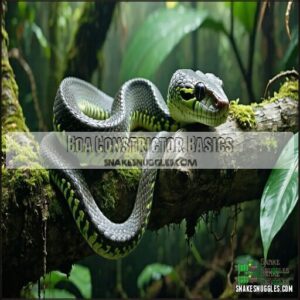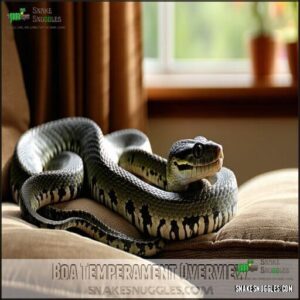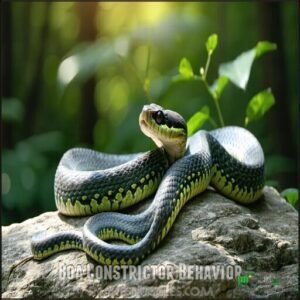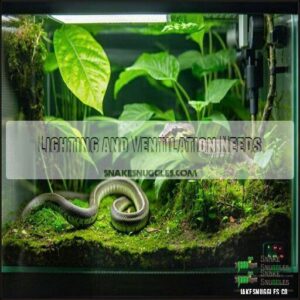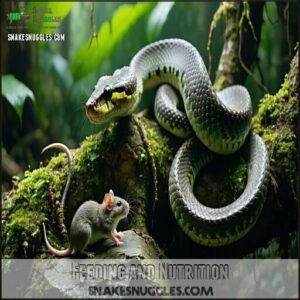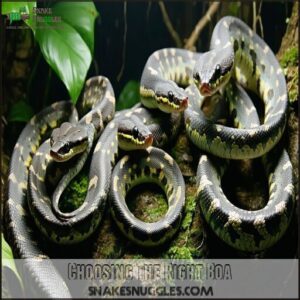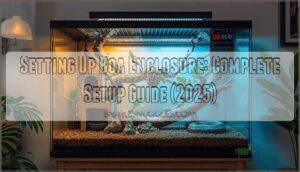This site is supported by our readers. We may earn a commission, at no cost to you, if you purchase through links.
 If you’re curious about the boa constrictor’s temperament for beginners, you’ll be pleased to know they’re generally calm, curious, and easy to handle.
If you’re curious about the boa constrictor’s temperament for beginners, you’ll be pleased to know they’re generally calm, curious, and easy to handle.
Think of them as the laid-back couch potatoes of the snake world—content to hang out while you provide proper care.
Boas are non-venomous, grow to manageable sizes (most around 6–9 feet), and rarely show aggression if treated gently.
They may hiss or puff up when stressed, but it’s more bark than bite, and with consistent handling, they’ll recognize your scent and become relaxed over time.
Stick around; caring for these gentle giants is simpler than it seems!
Table Of Contents
- Key Takeaways
- Boa Constrictor Basics
- Boa Temperament Overview
- Handling Boa Constrictors
- Boa Constrictor Behavior
- Health and Hygiene
- Habitat and Environment
- Feeding and Nutrition
- Choosing The Right Boa
- Cost and Long-Term Commitment
- Beginner-Friendly Boa Options
- Frequently Asked Questions (FAQs)
- Are boa constrictors good pets for beginners?
- Are boas high maintenance?
- Do boa constrictors like to be held?
- Are boa constrictors friendly to humans?
- How do boas interact with other pets?
- Can boas tolerate temporary changes in environment?
- What enrichment activities are best for boas?
- How do boa constrictors respond to strangers?
- Are boas vocal or make any sounds?
- Conclusion
Key Takeaways
- Boa constrictors are generally calm and docile snakes with a curious temperament, making them excellent pets for beginners who’ll find them relatively easy to handle with proper technique and patience.
- You’ll need to handle your boa 2-3 times weekly for about 10-15 minutes to build trust and recognition, always supporting their entire body and moving slowly to reduce stress and help them recognize your scent.
- Your boa will show clear signs when stressed or frightened (hissing, tight coiling), so you’ll quickly learn to read their body language and adjust your handling approach accordingly.
- You can expect a 20-30 year commitment with your boa constrictor, so you’ll need to plan for long-term care including proper enclosure size (growing to 6x2x2 feet for adults), temperature gradients (90-95°F basking area, 78-82°F cool side), and humidity levels (60-70%).
Boa Constrictor Basics
Boa constrictors come in a variety of types, colors, and sizes, making them fascinating pets to learn about.
With their manageable nature and long lifespans, they’re a perfect choice if you’re ready for a rewarding and long-term commitment.
Scientific Names and Types
Boa constrictors have two main types: Boa constrictor constrictor and Boa constrictor imperator.
Think of them as cousins with distinct traits. Common boas (imperator) are smaller and beginner-friendly, while redtail boas (constrictor) are larger and flashier.
Species identification matters for care and temperament. Beginners love common boas for their calm nature, while dwarf boas fit snugly in smaller spaces.
Common Nicknames and Morphs
Every boa has a unique look, earning nicknames like “redtail boa” for their vibrant tails or “common boa” for beginners.
Morph coloration, like albino or ghost, comes from selective breeding.
Popular morphs, such as blood sunglow or diamond, steal the show but may cost thousands.
Beginner morphs, with calm boa constrictor temperament, offer affordable, stunning options.
Size and Lifespan Expectations
Thinking about a pet snake? Boa constrictors can grow fast, with most reaching 6-10 feet depending on morphs.
They live long too—20-30 years, so long-term planning is a must.
Beginner-friendly, they require:
- Regular enclosure upgrades as they grow
- Space for their significant size
- Knowledge of boa constrictor temperament
- Commitment to their impressive lifespan
Boa Temperament Overview
In the context of snake temperament, boa constrictors are known for their calm and curious personalities.
Most boas are naturally docile, making them great for beginners.
However, temperament factors, like age and individual traits, can affect behavior.
While handling differences exist between species, many boas adapt well to beginner snake handling with patience.
Predicting behavior becomes easier as you spend time with them—some boas can act like the chill couch potatoes of the snake world!
Always respect their boundaries to build trust.
Handling Boa Constrictors
Handling a boa constrictor can be rewarding if you’re patient and gentle, but it takes practice to build trust.
Always support their body fully, keep movements slow, and don’t forget—they’re not fans of being squeezed!
Building Trust and Reducing Stress
Understanding boa constrictor temperament starts with trust. Gentle handling builds positive associations, while your scent recognition helps them feel safe.
Always read signals—hissing or tight coils mean, "Not today, friend!" Use safe enclosures for low-stress handling and create consistency.
Think of handling as a dance; slow, steady moves keep it graceful, not chaotic. Bonus: snakes appreciate calm vibes too!
Handling Frequency and Duration
Handle your boa constrictor 2-3 times a week for about 10-15 minutes.
This handling frequency strikes a balance between stress reduction and building trust.
Short sessions help your snake recognize your scent and temperament. Don’t overdo it—snakes need downtime too!
Remember, slow and steady wins the trust race when handling your new slithery friend. Keep it consistent!
Always use proper handling techniques to guarantee the safety of both you and your snake.
Proper Support and Grip Techniques
When handling boa constrictors, always use safe handling techniques to guarantee both comfort and safety.
Support their entire body with both hands, avoiding dangling. Use light grip pressure—firm enough to hold, but gentle to prevent stress.
Never squeeze; you’re handling a friend, not a garden hose.
Regular handling builds trust and helps your snake stay calm and comfortable while exploring, which is essential for a comfortable experience.
Boa Constrictor Behavior
Boa constrictors are curious creatures with predictable patterns, making them fascinating to observe once you understand their habits.
You’ll notice behaviors like shedding, exploring their enclosure, and even recognizing your scent over time, which can be quite fascinating.
Shedding and Brumation Cycles
Your boa’s shedding and brumation cycles are fascinating! Shedding frequency varies with age, diet, and health.
Watch for dull scales and cloudy eyes—shedding signs. Brumation triggers include cooler temperatures and shorter days.
Keep humidity levels steady (60-70%) to ease the shedding process. Temperature gradients help too. Young boas shed more frequently due to rapid growth spurts.
Stay alert to cycle variations and adjust the environment accordingly for a happy snake. To ensure your boa’s well-being, it’s crucial to monitor and respond to these cycle variations.
- Monitor humidity levels carefully.
- Provide a warm basking area.
- Watch for dull eyes or scales.
- Adjust feeding during brumation, as this can significantly impact your boa’s health and shedding process.
Breeding and Mating Behaviors
Courtship rituals are quite the show! Males slither over females, following pheromones, and use pelvic spurs during mating.
Polygynous males often stop eating mid-August, prioritizing breeding.
Boa constrictors are viviparous, with females carrying live young during a months-long gestation period.
With clutch sizes sometimes over 20 neonates, proper care is important immediately after birth.
| Trait | Description |
|---|---|
| Courtship | Males attracted via pheromones |
| Mating Style | Polygynous, with multiple mates |
| Gestation | Months-long, carrying live young |
| Clutch Size | Over 20 neonates possible |
Recognizing Owner’s Scent and Handling
It’s amazing how boa constrictors recognize their owner’s scent, almost like knowing their favorite hoodie.
To build trust and reduce stress, follow these steps:
- Wash your hands before handling.
- Use gentle handling techniques, supporting their entire body.
- Handle 2-3 times weekly to reinforce scent recognition.
- Move calmly to avoid startling them.
- Avoid strong-smelling soaps or perfumes when interacting to maintain a familiar scent.
Health and Hygiene
Keeping your boa healthy is all about smart habits and a keen eye for changes in behavior.
With proper hygiene and routine care, you can help your snake thrive and avoid common health issues.
Common Health Issues and Prevention
Keeping your boa healthy means watching for respiratory infections, scale rot, or pesky parasites.
These common health issues often pop up due to poor enclosure care.
Proper humidity, parasite prevention, and avoiding damp, dirty setups go a long way.
Don’t slack on checking your boa—early signs, like wheezing or dull scales, call for action.
Regular veterinary checkups? Always worth it!
Importance of Veterinary Care
Regular vet checkups keep your snake healthy and stress-free, especially for beginners learning boa constrictor temperament.
Parasite prevention and IBD awareness make a big difference, as these sneaky issues can cause trouble fast.
Watch for respiratory problems or scale rot—both need prompt veterinary care.
A trusted vet guarantees health issues are caught early, making your snake’s long life smoother.
Personal Hygiene and Pathogen Transmission
When handling your boa, hygiene isn’t just polite—it’s critical.
Snakes can carry zoonotic diseases, so keep germs at bay with these steps:
- Wash hands before and after handling (seriously, soap is your friend).
- Use gloves if your snake shows signs of illness.
- Follow strict sanitation protocols, like disinfecting tools.
- Schedule regular vet visits to prevent transmission of health issues.
Habitat and Environment
Creating the perfect habitat for your boa constrictor isn’t as hard as it sounds, but it does take some planning.
You’ll need to balance enclosure size, temperature, and humidity to keep your snake healthy and comfortable—think of it as designing a cozy getaway for your slithery friend.
Enclosure Size and Requirements
Boa constrictors need housing that grows with them.
Start with a 4x2x2-foot enclosure, ensuring escape prevention and proper ventilation.
Use sturdy enclosure materials like wood or plastic.
Add hiding spots for security and climbing structures for exercise.
Proper ventilation is essential for respiratory health.
With at least 10 square feet of floor space, your enclosure setup creates a safe, cozy home that matches your snake’s needs and playful nature.
Temperature and Humidity Gradients
A happy boa thrives with the right temperature zones. Create a thermal gradient by keeping the basking temperature at 90-95°F and cooler areas at 78-82°F.
Nighttime temperatures should drop slightly for natural cycles. For ideal regulation, consider a quality boa enclosure thermostat.
Humidity control is key—stick to 60-70%, upping it during shedding. Regular misting frequency and good humidity monitoring will make you a true humidity guru!
Lighting and Ventilation Needs
Good lighting and ventilation are essential for your boa’s health.
While UVB benefits aren’t required, a 12-hour light cycle mimics daylight.
Ventilation prevents stagnant air, supports humidity control, and keeps the enclosure fresh.
Use breathable enclosure materials to maintain airflow importance.
Combine proper lighting with effective heating to create a temperature gradient, ensuring your snake feels perfectly at home.
Feeding and Nutrition
Feeding your boa constrictor is straightforward, but you’ll need to match prey size to your snake’s girth for safety and proper nutrition.
Stick to a feeding schedule based on their age—weekly for younger boas and less often for adults—to keep them healthy and happy.
Diet and Prey Size Recommendations
Choosing Preyの種—the right prey for feeding boa constrictors prevents issues like obesity.
Hatchling diets start with mice, while adults prefer rats.
Prey size matters—don’t go larger than your snake’s widest part. Too big? Digestive struggles. Too small? Not enough nutrients.
Understanding appropriate boa prey is essential for their health.
- Prey Size: Match snake girth.
- Adult Nutrition: Rats or rabbits.
- Avoid Obesity: Right portions.
- Healthy Snake Feeding: Balanced prey.
Feeding Frequency and Schedules
Feeding boa constrictors is all about schedules and balance.
Hatchlings eat weekly, while adults need larger prey every 3-4 weeks.
Match prey size to the snake’s thickest part to prevent regurgitation risks or obesity.
Overfeeding can lead to a lazy, oversized snake—not ideal! Stick to a steady feeding frequency, and you’ll keep your boa healthy and happy long-term.
Avoiding Hand-Feeding and Regurgitation
Skip hand-feeding – it’s a recipe for accidental bites.
Use tongs to offer prey safely inside the enclosure. Stick to prey no bigger than your boa’s widest part.
Handle your snake only 48 hours post-meal to avoid regurgitation.
Overfeeding can lead to noticeable weight gain. If it happens, wait ten days before feeding again.
Proper feeding builds trust, ensuring your boa stays healthy and stress-free.
Choosing The Right Boa
Choosing the right boa starts with researching their species, size, and temperament to match your lifestyle.
Don’t worry—there’s a perfect boa out there for you, whether you’ve got limited space or big aspirations!
Researching Species and Morphs
Choosing the right boa means understanding species and morphs. Boa constrictors come in unique colors, calm temperaments, and beginner-friendly options.
Here’s what to know:
- Common Boas: Great size and calmness for beginners.
- Red-Tailed Boas: Vibrant but grow larger.
- Dwarf Boas: Compact, easy to handle.
- Morph Coloration: Hypo, Albino, others captivate!
- Morph Costs: Rare morphs cost over $10,000.
Considering Size and Space Constraints
As boas grow, so do their space requirements.
Hatchlings are fine in small tanks, but adults need spacious enclosures—think 6-8 feet long.
Dwarf boas are beginner-friendly, staying around 4-6 feet, which means fewer enclosure upgrades.
Always match enclosure size to the boa’s adult size, and trust me, cramming a 10-foot boa into a tiny tank isn’t a good look—or safe!
Evaluating Temperament and Handling Needs
Boa constrictor temperament varies, but many are docile, making them great for beginners.
Learn handling techniques to build trust—gentle, steady movements work best. Recognize stress signs like hissing or rapid movement; it means “back off.”
Boa personalities differ, so patience helps. Safe handling involves supporting their body evenly, like hugging a soft rope.
Using a snake handling tool can also provide additional safety and control. Follow this snake temperament guide for success.
Cost and Long-Term Commitment
Owning a boa constrictor isn’t cheap, and you’ll need to budget for both the initial setup and ongoing costs.
With a lifespan of 20-30 years, these snakes are truly a long-term commitment—think of it as adopting a pet that could outlast most cars!
Initial Purchase and Setup Costs
Starting with a boa constrictor means some upfront costs.
Enclosure costs depend on size but expect $200-$500. Heating equipment for a proper temperature gradient adds $50-$100.
Substrate choice, hides/decor, and an initial vet check may cost $100-$200. Beginners should prioritize safe, escape-proof housing to match a boa’s temperament.
Planning guarantees your snake thrives in its new home.
Ongoing Care and Maintenance Expenses
Taking care of your boa involves more than the initial setup.
You’ll need to budget for food costs, occasional enclosure upgrades, and enrichment items like climbing branches.
Heating replacements and reptile vet care are also regular expenses, and proper boa constrictor care guarantees their health.
But be ready for snake pet supplies and snake enclosure setup to keep adding up over time.
Planning for a 20-30 Year Lifespan
Thinking long-term is smart when caring for a boa constrictor over its 20-30 year lifespan.
Your commitment includes:
- Future Housing: Larger enclosures as they grow.
- Long-Term Costs: Food, vet visits, and equipment replacements.
- Owners Lifestyle: Is your routine boa-friendly?
- Inheritance Planning/Euthanasia Decisions: Who’ll care for your snake if you can’t?
Their temperament makes the effort worthwhile!
Beginner-Friendly Boa Options
Choosing the right boa for your first pet snake doesn’t have to feel overwhelming.
Some boas, like common boas and dwarf boas, are easier to care for and great for beginners.
Red-tail boas need more space and experience.
Common Boas for Beginners
A beginner’s dream, common boas combine a docile temperament with a manageable size.
Their easy availability and gentle nature make handling stress-free for beginners.
These snakes rarely bite and adjust well to 30-year commitments with proper care.
If you’re new to snakes, their calm nature feels like a warm welcome to the sphere of docile snake breeds.
Dwarf Boas and Their Suitability
A dwarf boa’s manageable size makes it a great choice for beginners.
These boas grow only 4–6 feet, fitting smaller spaces nicely.
Their calm temperament and adaptability build confidence for new owners.
Look for beginner-friendly boas like the Tarahumara or Crawl Cay, and when sourcing options, trust breeders offering healthy, captive-bred snakes to guarantee safety and the best boa for beginners.
Red-Tail Boas and Their Requirements
Red-tail boas are stunning, but their size demands commitment.
With lengths up to 10 feet, an enclosure upgrade is inevitable.
Their temperament differences make them less beginner-friendly than smaller boas, but regular handling helps.
A proper feeding schedule, spacious housing, and cost analysis are key.
Boa constrictor temperament shines when needs are met—just be ready for these vibrant giants!
Frequently Asked Questions (FAQs)
Are boa constrictors good pets for beginners?
Sure, because who wouldn’t want a long, scaly companion?
Seriously though, boa constrictors make great pets for beginners. They’re calm, manageable in size, and thrive with proper care.
But remember, they’re a 20+ year commitment!
Are boas high maintenance?
Boas aren’t too high-maintenance, but they do need consistent care.
You’ll manage heating, humidity, feeding schedules, and cleaning.
While it’s a commitment, their relaxed nature and fascinating behavior make it worth the effort.
Do boa constrictors like to be held?
Picture a boa curling comfortably in your hands—it’s not exactly a cuddle, but they tolerate handling well if you’re gentle and consistent.
They’ll get to know you, but don’t expect puppy-like affection!
Are boa constrictors friendly to humans?
Boa constrictors aren’t exactly cuddly, but they’re surprisingly calm and tolerate handling well.
With regular, gentle interaction, they can recognize you and feel secure, making them a fascinating pet—not your typical scaly best friend, which is a surprisingly fascinating aspect.
How do boas interact with other pets?
Keep your boa separate from other pets.
They’ll view small animals like rodents as food, not friends.
Bigger pets, like dogs, can stress them out or accidentally hurt them.
Supervise interactions carefully to guarantee safety.
Can boas tolerate temporary changes in environment?
You might worry about stressing a boa with changes, but they’re surprisingly adaptable.
Brief environment shifts, like enclosure cleaning, are fine.
Just maintain their temperature and humidity needs, and you’ll avoid turning them into cranky noodles!
What enrichment activities are best for boas?
Give your boa textured branches to climb, tunnels to explore, and items they can slither around.
Switch up their enclosure layout occasionally—kind of like redecorating their home—so they stay curious and engaged.
How do boa constrictors respond to strangers?
Approach with calm confidence, as boas sense your energy.
They’re curious yet cautious with strangers, often observing before reacting.
Handling helps them adjust, but sudden moves? That’s a no-no—they’ll coil tighter than your earbuds, with calm confidence and sudden moves being key to their behavior.
Are boas vocal or make any sounds?
Boas aren’t vocal, but they hiss when threatened or stressed.
It’s their way of saying, “Back off!”
They don’t have vocal cords, so don’t expect chirps or growls—just the occasional warning hiss.
Conclusion
Meet Sarah, who transformed from a nervous beginner to a confident snake owner in just months.
With proper research and care, you’ll discover that the boa constrictor temperament for beginners is ideal—docile yet engaging.
You’ll build a rewarding bond as your boa recognizes your scent and relaxes during handling sessions.
Remember, these gentle giants need commitment, but they’ll reward you with decades of fascinating companionship that few other pets can match.
- https://reptifiles.com/boa-constrictor-care/boa-species-subspecies/
- https://www.craiglehoullier.com/blog1/2020/12/8/2020-garden-year-in-review-released-dwarf-tomatoes
- https://www.itis.gov/servlet/SingleRpt/SingleRpt?search_topic=TSN&search_value=174321
- http://www.humanesociety.org/assets/pdfs/wildlife/captive/captive-constrictor-snake-incidents.pdf
- http://www.bioone.org/doi/abs/10.1670/45-04N

